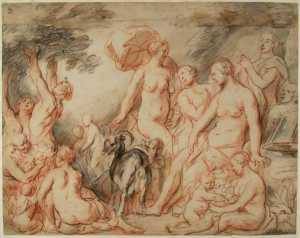The drawing portrays Diana, goddess of the hunt, with her retinue of nymphs, satyrs and putti. True to tradition the women are shown scantily clad. The fruit shaken from the tree by the satyrs on the left is being given to the goddess by a putto in the foreground on the right. In the centre stands the goat Amalthea, celebrated for her milk, which fed the young god Jupiter. It is a picture of abundance, a glorifcation of nature - a popular subject with Jordaens., Abundance and fertility are favourite subjects in Jordaens’s work. In this drawing we see a goddess surrounded by nymphs and satyrs. Fruit is being picked and carried away. The goat may represent Amalthea, who suckled the infant Jupiter. When one of her horns broke off it transformed into the cornucopia – the horn of plenty.

Specifications
| Title | Allegory of Abundance |
|---|---|
| Material and technique | Black and red chalk, brush and brown ink on paper |
| Object type |
Drawing
> Two-dimensional object
> Art object
|
| Location | This object is in storage |
| Dimensions |
Height 235 mm Width 295 mm |
|---|---|
| Artists |
Draughtsman:
Jacob Jordaens (I)
|
| Accession number | V 30 (PK) |
| Credits | Loan Stichting Museum Boijmans Van Beuningen (former Koenigs collection), 1940 |
| Department | Drawings & Prints |
| Acquisition date | 1940 |
| Creation date | in circa 1640-1645 |
| Collector | Collector / Franz Koenigs |
| Internal exhibitions |
Rubens, Jordaens, Van Dyck en tijdgenoten (2001) Hans Makarts Abundantia (2012) |
| Material | |
| Object | |
| Geographical origin | Southern Netherlands > The Netherlands > Western Europe > Europe |
All about the artist
Jacob Jordaens (I)
Antwerpen 1593 - Antwerpen 1678
Jacob Jordaens worked as an assistant of Rubens. After the death of Rubens, Jordaens completed a number of paintings that were intended for Spain. The influence...
Bekijk het volledige profiel
























